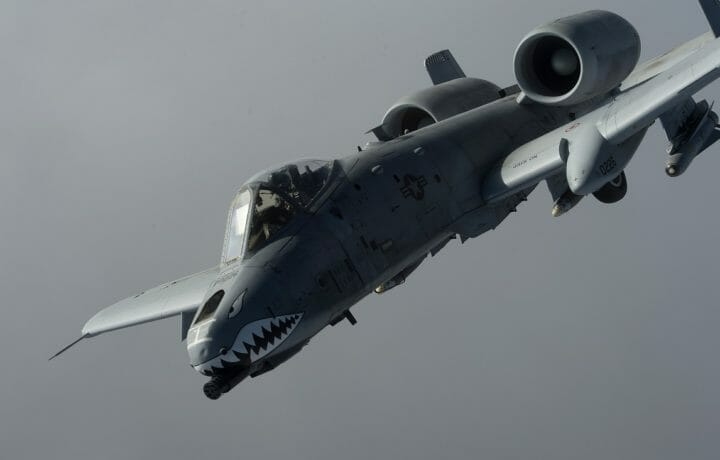If United States Air Force officials get their way, they’ll retire as many as 250 aircraft in the coming year. In its Fiscal Year 2025 (FY25) budget request, the service called for retiring many of its aging aircraft while using the savings from maintaining those old warbirds towards future needs including its Next Generation Air Dominance (NGAD) program. That system of systems calls for an optionally-manned sixth-generation fighter and unmanned aerial systems (UAS) that would act as so-called “loyal wingmen.”
On the proposed chopping block would be 56 of the Air Force’s Fairchild Republic A-10 Thunderbolt II subsonic attack aircraft. The airframe was developed to provide close-air support (CAS) to friendly ground troops by attacking armored vehicles, tanks, and other enemy ground forces – and remains the only production-built aircraft for the U.S. Air Force to serve solely in a CAS role.
If the Air Force’s request to retire the A-10 aircraft is approved, it would be the largest divestment from the service of the CAS to date. Congress had previously approved a call from the Air Force to send 21 of the Thunderbolt IIs – also known by its pilots as the Warthog – to the “Boneyard,” the more commonly used name of the 309th Aerospace Maintenance and Regeneration Group (309th AMARG). Located at Davis-Monthan Air Force Base (AFB), Arizona, it is where nearly 4,000 out-of-service aircraft from all branches of the U.S. military are stored.
End of the Line For the Warthog
Air Force officials have been trying to retire the fleet of A-10s for years, but lawmakers have pushed back – refusing the service to cut back on the aging aircraft. However, the 2024 National Defense Authorization has eased the current restrictions, and the entire force of Thunderbolt IIs is now on track to be retired by the end of the decade.
The 355th Wing began divesting its fleet of A-10 Thunderbolt II aircraft with aircraft 82-648 last month, and it didn’t have to go far. The 354th Fighter Squadron has also operated out of Davis-Monthan AFB since March 1975.
Pilots and maintainers at Davis-Monthan will move onto the F-35 aircraft due to the divestment.
“The A-10 has been the symbol of Davis-Monthan Air Force Base for many years, and it will continue to be a symbol for the Airmen of DM, a symbol of their commitment, excellence and service,” said U.S. Air Force Col. Scott Mills, 355th Wing commander and A-10 pilot. “For now, we’re divesting a single squadron during the summer-fall timeframe of 2024.”
Originally designed for CAS by Fairchild Republic, the first A-10 model could carry bombs and rockets on 11 pylons and featured a 30mm GAU-8/A rotary cannon protruding from the nose of the aircraft. The first A-10A arrived at Davis-Monthan on March 2, 1976, and it was assigned to the 355th Tactical Fighter Wing, replacing the Vought A-7D Corsair flown by the 355th TFW.
National Guard Retirements Also Coming
Additional A-10 squadrons will also send their aging CAS aircraft to the boneyard. That includes Maryland’s Warfield Air National Guard Base at Martin State Airport, which will transition from its flying mission with the A-10 to a cyber wing mission.
The 175th Fighter Wing will receive a cyber mission, creating a natural synergy with cyber assets at Fort George G. Meade, Maryland, and the 175th Cyberspace Operations Group already operating out of Warfield ANGB, the service announced early this month. Twenty-one of the A-10s from Warfield are among the A-10s being divested this fall.
Some Maryland lawmakers have been opposed to the retirement of the A-10s, citing the loss of jobs, while it could also leave Maryland as the only state without a flying mission.
“The Maryland Air National Guard has flown A-10s since 1979, making it one of the most experienced A-10 units in the Air Force. Any new cyber wing must be fully resourced in order to build the facilities and train personnel,” Maryland Governor Wes Moore said in a statement. “We are disappointed to learn of the Air Force’s decision to hurriedly retire the A-10 mission across the nation, including the mission at Martin State, without a plan to retain experienced pilots and maintainers or to replace older systems with advanced aircraft.”
The 175th Wing may get one final hurrah with the A-10s, as the unit is still scheduled to deploy with the A-10s to U.S. Central Command (CENTCOM) in the Middle East.
Personnel Cuts
As Military.com reported, the retirement of the A-10s will also mean that the Air Force will scale back on the number of elite airmen responsible for calling in close-air support on the battlefield. The service plans to shrink the Tactical Air Control Party (TACP) strength to about 2,130 personnel – down by about 44%.
In a statement, Troops-In-Contact, an advocacy group led by A-10 and air support veterans, warned that CAS remains crucial to the military.
“If successful, this plan would kill the CAS profession and cripple America’s CAS capability,” the group wrote on its website. “Ground troops would be supported, if at all, by CAS amateurs in a small, expensive fleet of fragile aircraft that are far less effective. In low-intensity conflict, that will cost lives.”
Supporters of the A-10 have also warned that the Lockheed Martin F-35 Lightning II, which was designed as a multirole aircraft, may lack some of the CAS capabilities of the Warthog.
Yet, the Air Force remains committed to retiring the A-10, arguing that the Cold War-era aircraft isn’t well-suited to a conflict with near-peer adversaries including China and Russia.




